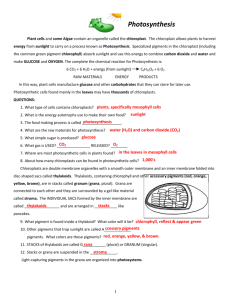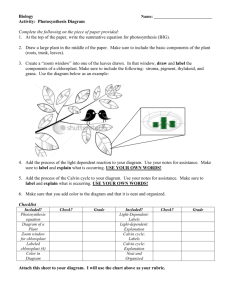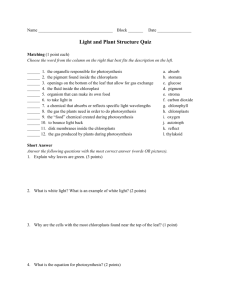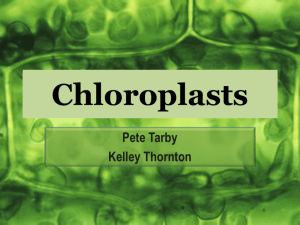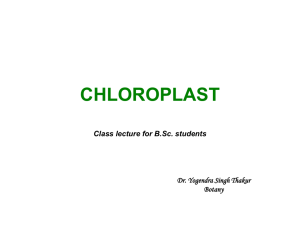Chloroplasts Worksheet
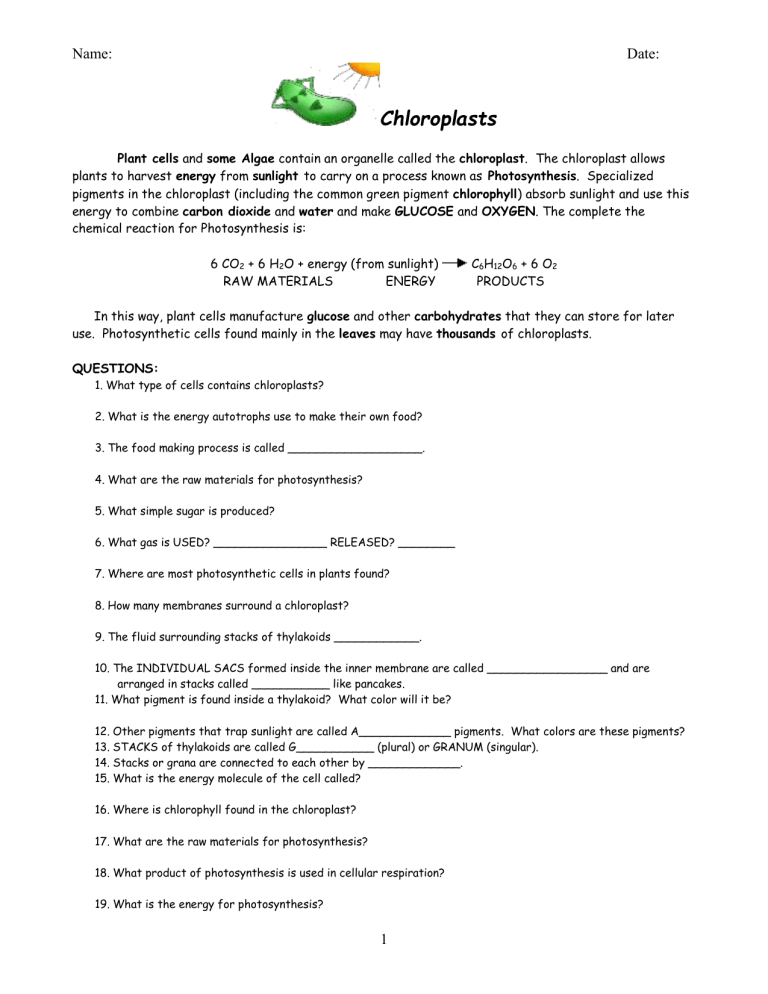
Name: Date:
Chloroplasts
Plant cells and some Algae contain an organelle called the chloroplast. The chloroplast allows plants to harvest energy from sunlight to carry on a process known as Photosynthesis. Specialized pigments in the chloroplast (including the common green pigment chlorophyll) absorb sunlight and use this energy to combine carbon dioxide and water and make GLUCOSE and OXYGEN. The complete the chemical reaction for Photosynthesis is:
6 CO
2
+ 6 H
2
O + energy (from sunlight) C
6
H
12
O
6
+ 6 O
RAW MATERIALS ENERGY PRODUCTS
2
In this way, plant cells manufacture glucose and other carbohydrates that they can store for later use. Photosynthetic cells found mainly in the leaves may have thousands of chloroplasts.
QUESTIONS:
1.
What type of cells contains chloroplasts?
2.
What is the energy autotrophs use to make their own food?
3.
The food making process is called ___________________.
4.
What are the raw materials for photosynthesis?
5.
What simple sugar is produced?
6.
What gas is USED? ________________ RELEASED? ________
7.
Where are most photosynthetic cells in plants found?
8.
How many membranes surround a chloroplast?
9.
The fluid surrounding stacks of thylakoids ____________.
10.
The INDIVIDUAL SACS formed inside the inner membrane are called _________________ and are arranged in stacks called ___________ like pancakes.
11.
What pigment is found inside a thylakoid? What color will it be?
12.
Other pigments that trap sunlight are called A_____________ pigments. What colors are these pigments?
13.
STACKS of thylakoids are called G___________ (plural) or GRANUM (singular).
14.
Stacks or grana are connected to each other by _____________.
15.
What is the energy molecule of the cell called?
16.
Where is chlorophyll found in the chloroplast?
17.
What are the raw materials for photosynthesis?
18.
What product of photosynthesis is used in cellular respiration?
19.
What is the energy for photosynthesis?
1
Name: Date:
Chloroplasts are double membrane organelles with a smooth outer membrane and an inner membrane folded into disc-shaped sacs called thylakoids. Color and label the outer membrane light green. Thylakoids, containing chlorophyll and other accessory pigments (red, orange,
yellow, brown), are in stacks called granum (grana, plural). Color and label the grana (STACK) dark green in Figure 1. Grana are connected to each other by structures called lamellae, and they are surrounded by a gel-like material called stroma. Color and label the stroma light blue in Figure 1.
FIGURE 1-CHLOROPLAST
Light-capturing pigments in the grana are organized into photosystems. On Figure 2, color
and label a single thylakoid (SINGLE DISK) dark green. In figure 2, color and label a granum
(STACK) red.




